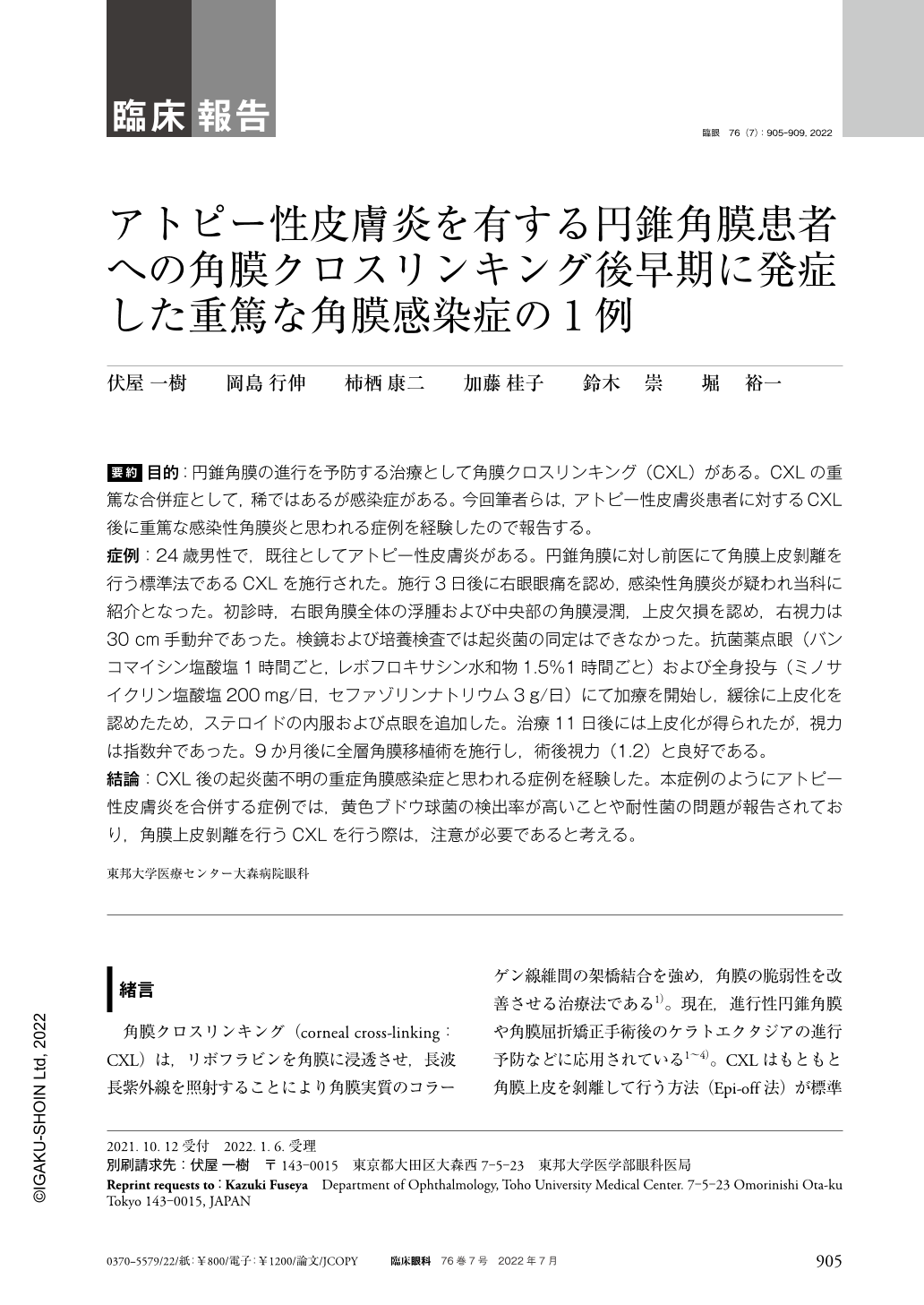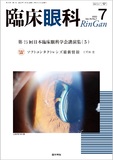Japanese
English
- 有料閲覧
- Abstract 文献概要
- 1ページ目 Look Inside
- 参考文献 Reference
要約 目的:円錐角膜の進行を予防する治療として角膜クロスリンキング(CXL)がある。CXLの重篤な合併症として,稀ではあるが感染症がある。今回筆者らは,アトピー性皮膚炎患者に対するCXL後に重篤な感染性角膜炎と思われる症例を経験したので報告する。
症例:24歳男性で,既往としてアトピー性皮膚炎がある。円錐角膜に対し前医にて角膜上皮剝離を行う標準法であるCXLを施行された。施行3日後に右眼眼痛を認め,感染性角膜炎が疑われ当科に紹介となった。初診時,右眼角膜全体の浮腫および中央部の角膜浸潤,上皮欠損を認め,右視力は30cm手動弁であった。検鏡および培養検査では起炎菌の同定はできなかった。抗菌薬点眼(バンコマイシン塩酸塩1時間ごと,レボフロキサシン水和物1.5%1時間ごと)および全身投与(ミノサイクリン塩酸塩200mg/日,セファゾリンナトリウム3g/日)にて加療を開始し,緩徐に上皮化を認めたため,ステロイドの内服および点眼を追加した。治療11日後には上皮化が得られたが,視力は指数弁であった。9か月後に全層角膜移植術を施行し,術後視力(1.2)と良好である。
結論:CXL後の起炎菌不明の重症角膜感染症と思われる症例を経験した。本症例のようにアトピー性皮膚炎を合併する症例では,黄色ブドウ球菌の検出率が高いことや耐性菌の問題が報告されており,角膜上皮剝離を行うCXLを行う際は,注意が必要であると考える。
Abstract Purpose:Corneal crosslinking(CXL)is a treatment to prevent the progression of keratoconus, and infection is a rare but serious complication of CXL. Herein, we report a case of severe infectious keratitis after CXL in a patient with atopic dermatitis.
Case:The patient was a 24-year-old male with a history of atopic dermatitis. He underwent CXL for keratoconus using the standard method of corneal epithelial detachment at his previous clinic. Three days after the procedure, he developed ocular pain in his right eye, following which he was referred to our hospital because of suspicion of infectious keratitis. At the time of the initial examination, edema of the entire right cornea, central corneal infiltration, and epithelial defects were observed, and the visual acuity of the right eye was 30 cm hand motion. Smear examination and culture tests failed to identify the causative organism. Treatment was started with topical antimicrobial eye drops(vancomycin hydrochloride, hourly;1.5% levofloxacin hydrate, hourly)and systemic antibiotic administration(minocycline hydrochloride 200 mg/day, cefazolin sodium 3 g/day). Nine months later, a full corneal transplant was performed, and the patient had good postoperative corrected visual acuity(1.2).
Conclusion:We experienced a case of suspected a severe corneal infection with an unknown pathogen after CXL. The detection rate of Staphylococcus aureus is high in patients with atopic dermatitis, as in this case, and the problem of resistant bacteria has been reported. Therefore, we believe that caution is necessary when performing CXL with corneal epithelial removal.

Copyright © 2022, Igaku-Shoin Ltd. All rights reserved.


